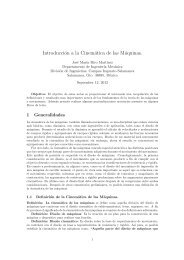Sistema Vibratorio de un Grado de Libertad Amortiguado - fimee ...
Sistema Vibratorio de un Grado de Libertad Amortiguado - fimee ...
Sistema Vibratorio de un Grado de Libertad Amortiguado - fimee ...
You also want an ePaper? Increase the reach of your titles
YUMPU automatically turns print PDFs into web optimized ePapers that Google loves.
Por lo tanto<br />
yn<br />
yn+m<br />
= e<br />
2 mπ<br />
c<br />
cc<br />
− 1−( c<br />
cc ) 2<br />
o<br />
yn+m<br />
En particular, se tiene que si m = 1, entonces<br />
yn<br />
yn+1<br />
= e<br />
2 π<br />
c<br />
cc − 1−( c<br />
cc ) 2<br />
o<br />
yn<br />
yn+1<br />
yn<br />
= e<br />
= e<br />
2 mπ c<br />
cc<br />
1−( c<br />
cc ) 2<br />
<br />
2 π c<br />
cc <br />
1−( c<br />
cc ) 2<br />
(21)<br />
(22)<br />
Esta es <strong>un</strong>a característica <strong>de</strong> los sistemas vibratorios con amortiguamiento<br />
lineal, la relación <strong>de</strong> “amplitu<strong>de</strong>s” consecutivas, es siempre constante. De<br />
la ecuación (21), se <strong>de</strong>ducirá <strong>un</strong>a ecuación para <strong>de</strong>terminar la relación <strong>de</strong><br />
amortiguamiento.<br />
<br />
<br />
<br />
ln <br />
<br />
<br />
yn<br />
<br />
<br />
<br />
yn+1<br />
=<br />
2 π c<br />
cc <br />
1 − c<br />
cc<br />
Manipulando algebraicamente el resultado anterior, se tiene que<br />
<br />
c 2 <br />
<br />
1 − ln <br />
cc<br />
<br />
<br />
<br />
<br />
ln <br />
<br />
o, finalmente<br />
<br />
yn<br />
2<br />
<br />
<br />
yn+m<br />
<br />
<br />
yn<br />
2<br />
<br />
<br />
yn+m <br />
c<br />
cc<br />
2<br />
c<br />
cc<br />
=<br />
=<br />
=<br />
=<br />
2<br />
<br />
2 mπ c<br />
2 cc<br />
⎡<br />
<br />
c 2<br />
⎣4 m<br />
cc<br />
2 π 2 <br />
⎤<br />
<br />
yn<br />
2<br />
<br />
+ ln ⎦<br />
yn+m<br />
<br />
<br />
yn 2<br />
ln <br />
yn+m<br />
4 m2 π2 + <br />
ln 1<br />
<br />
yn 2 = ⎡<br />
<br />
yn+m 1+ ⎣ 2<br />
mπ<br />
<br />
ln yn<br />
1<br />
<br />
⎡<br />
<br />
<br />
1+ ⎣ 2 mπ<br />
yn ln<br />
y n+m<br />
⎤2<br />
⎦<br />
<br />
<br />
y n+m<br />
⎤2<br />
⎦<br />
<br />
<br />
(23)<br />
La ecuación (23) proporciona la solución exacta <strong>de</strong> la relación <strong>de</strong> amortiguamiento<br />
cuando se conocen las “amplitu<strong>de</strong>s” máximas yn y yn+m. Es<br />
curioso que esta ecuación (23) no aparezca en muchos <strong>de</strong> los libros <strong>de</strong> vibraciones<br />
mecánicas pero si en los libros <strong>de</strong> sistemas <strong>de</strong> control automático. La<br />
14



